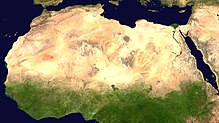
Back تخضير الصحراء Arabic মরু সবুজায়ন Bengali/Bangla Enverdecimiento del desierto Spanish بیابانزدایی Persian Végétalisation du désert French 砂漠緑化 Japanese Penghijauan gurun Malay

Desert greening is the process of afforestation or revegetation of deserts for ecological restoration (biodiversity), sustainable farming and forestry, but also for reclamation of natural water systems and other ecological systems that support life. The term "desert greening" is intended to apply to both cold and hot arid and semi-arid deserts (see Köppen climate classification system). It does not apply to ice capped or permafrost regions. It pertains to roughly 32 million square kilometres of land. Deserts span all seven continents of the Earth[1] and make up nearly a fifth of the Earth's landmass,[2] areas that recently have been increasing in size.[3]
As some of the deserts expand[4] and global temperatures increase,[5] the different methods of desert greening may provide a possible response.[6] Planting suitable flora in deserts has a range of environmental benefits from carbon sequestration to providing habitat for desert fauna to generating employment opportunities to creation of habitable areas for local communities.[7]
The prevention of land desertification is one of 17 Sustainable Development Goals outlined by the United Nations.[8] Desert greening is a process that aims to not only combat desertification but to foster an environment where plants can create a sustainable environment for all forms of life while preserving its integrity.
- ^ "Desert". National Geographic (grades 6–12). Retrieved 16 November 2023.
- ^ "Deserts". NatureWorks. nhpbs.org. Retrieved 16 November 2023.
- ^ Liu, Ye; Xue, Yongkang (5 March 2020). "Expansion of the Sahara Desert and shrinking of frozen land of the Arctic". Scientific Reports. 10 (1): 4109. Bibcode:2020NatSR..10.4109L. doi:10.1038/s41598-020-61085-0. PMC 7057959. PMID 32139761.
- ^ "Is the Sahara Desert Growing?". Earth.Org. Retrieved 16 November 2023.
- ^ "World of Change: Global Temperatures". NASA Earth Observatory. 29 January 2020. Retrieved 16 November 2023.
- ^ Liu, Xiaoyu; Xin, Liangjie (30 August 2021). "China's deserts greening and response to climate variability and human activities". PLOS ONE. 16 (8): e0256462. Bibcode:2021PLoSO..1656462L. doi:10.1371/journal.pone.0256462. PMC 8405022. PMID 34460859.
- ^ Isaifan, Rima J.; Baldauf, Richard W. (2020). "Estimating Economic and Environmental Benefits of Urban Trees in Desert Regions". Frontiers in Ecology and Evolution. 8. doi:10.3389/fevo.2020.00016. PMC 7970529. PMID 33746692.
- ^ "Climate action". The Sustainable Development Goals Report 2023: Special Edition. 2023. pp. 38–39. doi:10.18356/9789210024914c017. ISBN 978-92-1-002491-4.[page needed]
© MMXXIII Rich X Search. We shall prevail. All rights reserved. Rich X Search